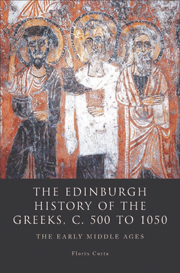Book contents
- Frontmatter
- Contents
- List of Illustrations
- List of Tables
- Acknowledgements
- Series Editor's Preface
- Introduction
- 1 The last century of Roman power (c. 500 to c. 620): army, church, and countryside
- 2 Collapse or adaptation? The problem of the urban decline in late antique Greece
- 3 Invasion or inflation? Hoards and barbarians in sixth- and early seventh-century Greece
- 4 Dark-Age Greece (c. 620 to c. 800)
- 5 Revival and expansion (c. 800 to c. 900)
- 6 The beginning of prosperity (c. 900 to c. 1050)
- 7 Early medieval Greece and the Middle Byzantine economy
- 8 Social structures and Byzantine administration in early medieval Greece
- 9 Christianity in early medieval Greece
- 10 Conclusion: the people of early medieval Greece
- Bibliography
- Index
2 - Collapse or adaptation? The problem of the urban decline in late antique Greece
Published online by Cambridge University Press: 05 August 2013
- Frontmatter
- Contents
- List of Illustrations
- List of Tables
- Acknowledgements
- Series Editor's Preface
- Introduction
- 1 The last century of Roman power (c. 500 to c. 620): army, church, and countryside
- 2 Collapse or adaptation? The problem of the urban decline in late antique Greece
- 3 Invasion or inflation? Hoards and barbarians in sixth- and early seventh-century Greece
- 4 Dark-Age Greece (c. 620 to c. 800)
- 5 Revival and expansion (c. 800 to c. 900)
- 6 The beginning of prosperity (c. 900 to c. 1050)
- 7 Early medieval Greece and the Middle Byzantine economy
- 8 Social structures and Byzantine administration in early medieval Greece
- 9 Christianity in early medieval Greece
- 10 Conclusion: the people of early medieval Greece
- Bibliography
- Index
Summary
According to the Synekdemos of Hierokles, by 500 there were about eighty cities in the province of Achaia, apparently one of the most highly urbanised regions of the eastern Mediterranean (Honigman 1939: 7 and 16–19; see also Bon 1951: 21 and 23–4). Most of them had no appropriate defence. Prokopios mentions fortifications being renewed for all cities south of the Thermopylae Pass, and specifically mentions Corinth, the walls of which had been ruined by ‘terrible earthquakes which had visited the city’, Athens, Plataea, and ‘the towns of Boeotia’ (Buildings 4.2). But he also claims that the fortifications of cities in central Greece and Peloponnesos had fallen into ruin long before Justinian's reign. The Emperor's intention was apparently to rebuild the walls of all the cities south of the Thermopylae Pass, but realising that the operation would take too long, he decided ‘to wall the whole Isthmus securely’. The implication is that most, if not all cities south of the Hexamilion remained unfortified. North of the Thermopylae Pass, Prokopios mentions the rebuilding of fortifications at Echinos, Thebes, Pharsalos, Demetrias, Metropolis, Gomphi, and Trika (Trikala), with only Kassandria (Potidaea) mentioned in Macedonia (Buildings 4.2). Conspicuously absent from this list is the great Macedonian metropolis of Thessalonica, the largest city in the Balkans and the second city of the Empire after Constantinople. Indeed, the evidence available so far suggests that although Emperor Justinian certainly contributed to the decoration or endowment of the basilica of St Demetrios in Thessalonica, the repair or extension of the city fortifications is a much earlier work, some of which at least was paid for by private citizens.
- Type
- Chapter
- Information
- The Edinburgh History of the Greeks, c. 500 to 1050The Early Middle Ages, pp. 48 - 67Publisher: Edinburgh University PressPrint publication year: 2011



